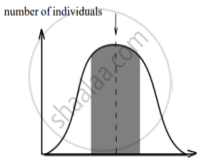Advertisements
Advertisements
प्रश्न
Very short answer question.
State the Hardy – Weinberg equilibrium.
उत्तर
- The Hardy-Weinberg equilibrium law states that at the equilibrium point, both the gene (allele) frequency and genotypic frequency remain constant from generation to generation.
- generation, in the diploid, sexually reproducing, large, free interbreeding population in which mating is random, and there is the absence of any other factors that change the allele frequency
APPEARS IN
संबंधित प्रश्न
Give the graphical representation of Hardy· Weinberg's principle in the form of Punnet Square.
State Hardy-Weinberg’s principle.
How does the Hardy-Wienberg equation explain genetic equilibrium?
How does Hardy-Weinberg’s expression (p2+2pq+q2=1) explain that genetic equilibrium is maintained in a population? List any four factors that can disturb the genetic equilibrium.
Disturbance of Hardy - Weinberg equilibrium results in
Which type of selection explains industrial melanism observed in moth, Biston bitularia ______.
How is Hardy-Weinberg's expression “(p2 + 2pq + q2) = 1” derived?
List any two factors that can disturb the genetic equilibrium.
The graphs below show three types of natural selection. The shaded areas marked with arrows show the individuals in the population who are not selected. The dotted vertical lines show the statistical means.
 |
 |
 |
| character Graph A |
character Graph B |
character Graph C |
- What names are given to the types of selection shown in graphs A, B and C?
- After the selection has operated for several generations in the above populations indicated as, Graph A, B and C, graphically illustrate the probable results.
A population of 200 fruit flies is in Hardy Weinberg equilibrium. The frequency of the allele (a) 0.4. Calculate the following:
The number of homozygous dominant fruit flies.
